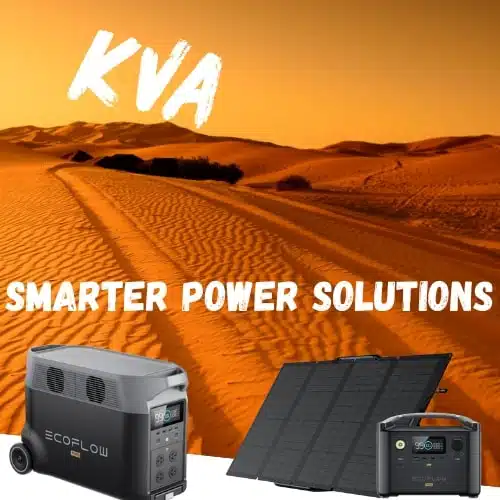In an increasingly mobile world, the need for portable and reliable power sources has never been greater. Portable power stations have emerged as a versatile solution for outdoor enthusiasts, campers, emergency preparedness, and even everyday use. This comprehensive guide will take you through the world of portable power stations, covering their functionalities, applications, types, and essential factors to consider when purchasing one. A lithium power station makes the perfect camping battery or caravan battery.

So What Are Portable Power Stations?
Portable power stations, also known as portable solar generators or power banks, are compact and lightweight devices designed to store electrical energy and provide power when you’re off the grid or during power outages. They typically consist of a battery, an inverter, various output ports (AC, DC, USB), and a way to recharge, often through solar panels, wall outlets, or car chargers.
Understanding Battery Size and Capacity for Portable Power Stations
1. What is the difference between inverter size and battery size?
- Inverter Size: The inverter size (measured in watts, W) determines the maximum power output that the portable power station can provide at any given time. For example, a 2400W inverter can run devices that cumulatively draw up to 2400 watts of power.
- Battery Size: The battery size (measured in watt-hours, Wh) indicates the total energy storage capacity of the power station. A 2048Wh battery can deliver 2048 watts for one hour or 1024 watts for two hours, and so on.
2. What appliances can I run with a 2400W inverter and a 2048Wh battery?
A 2400W inverter can handle most household appliances, but the runtime depends on the power consumption of each device. Here are some examples:
- Laptop (50W): Approximately 40 hours
- Refrigerator (150W): About 13.5 hours
- LED TV (100W): Around 20.5 hours
- Microwave (1000W): Roughly 2 hours
- Coffee Maker (800W): About 2.5 hours
3. How long will it take to recharge the battery using different methods?
- Solar Panels: Charging time varies based on solar panels output and sunlight conditions. For example, an 800W solar panel setup in optimal conditions can recharge a 2048Wh battery in about 3 hours.
- Generator: Using a smart generator with an 1800W output can recharge the battery in approximately 1.1 hours.
- 800W Alternator Charger: Similar to the generator, an 800W alternator charger can fully recharge the battery in about 2 hours.
4. How are portable power station products described?
Portable power stations are typically described by their inverter size and battery capacity. For example:
- Inverter Size: The maximum power output the device can handle at one time, such as 2400W.
- Battery Capacity: The total energy storage, like 2048Wh, indicating how much energy can be stored and used.
5. Why is understanding inverter size and battery capacity important?
Knowing the inverter size helps you determine which devices you can run simultaneously without overloading the power station. Understanding battery capacity allows you to estimate how long you can power your devices before needing to recharge.
6. What factors affect the performance and runtime of my portable power station?
Several factors can impact performance:
- Device Power Consumption: Higher wattage devices will drain the battery faster.
- Battery Efficiency: Over time, battery efficiency may decrease, reducing runtime.
- Environmental Conditions: Extreme temperatures can affect battery performance.
- Charging Source: The efficiency and power output of your charging method (solar, generator, alternator) will influence how quickly the battery recharges.
By understanding these key aspects, you can make informed decisions about selecting and using portable power stations for your needs. If you have further questions or need specific recommendations, feel free to contact our customer support team.
Applications and Use Cases – Camping Battery
Portable power stations have a wide range of applications, making them indispensable in various scenarios:
- Camping and Outdoor Adventures: Power your camping trips, charge devices, run lights, or even power small appliances.
- Emergency Backup: Keep essential devices running during power outages, ensuring communication and safety.
- Events: Run electronics, small appliances, or power outdoor entertainment setups.
- Caravan, RV and Van Life: Provide electricity in your mobile home or van without relying on a traditional generator.
- Remote Work: Stay connected and productive by powering your devices and internet equipment in remote locations.
Types of Lithium Power Station
Portable power stations come in several types, each catering to different needs:
- Battery Capacity: Varying from small, pocket-sized units to larger, high-capacity stations.
- Solar-Powered: Equipped with built-in solar panels or compatible for solar panel integration for eco-friendly recharging of a lithium power station.
- Portable Power Banks: Smaller and highly portable units for charging small devices like smartphones and tablets.
Factors to Consider When Choosing a battery power supply :
Selecting the right portable power station requires careful consideration of several factors:
- Capacity: Determine how much power you need based on the devices you plan to run and for how long.
- Battery Type: Lithium-ion batteries are common for their high energy density and longer life.
- Input and Output Ports: Ensure the station has the necessary ports for your devices, including AC outlets, USB ports, and DC outlets.
- Weight and Portability: Consider how often you’ll need to transport the unit and choose a weight that suits your needs.
- Recharge Options: Evaluate the available charging methods, such as solar, wall outlets, car chargers, or even hand-cranked options for emergencies.
- Inverter Quality: A high-quality inverter ensures stable and clean 240V power output.
- Durability and Build: Look for rugged and weather-resistant designs for outdoor use.
- Brand Reputation: Research the manufacturer’s reputation, customer reviews, and warranty options.

Maintenance and Care
While portable power stations are relatively low-maintenance, here are some tips to ensure their longevity:
- Regular Charging: Keep the unit charged if not in use to prevent the battery from draining completely.
- Cleanliness: Keep the ports and vents clean to prevent dust and debris from affecting performance.
- Storage: Store the power station in a cool, dry place away from extreme temperatures.
- Battery Health: If the unit uses lithium-ion batteries, avoid overcharging or deep discharging, as it can reduce battery life.
Portable power stations are versatile and indispensable devices that provide a reliable power source in various situations, from outdoor adventures to emergency backup. When considering options, consider factors like capacity, battery type, and recharge options to meet your specific needs.

